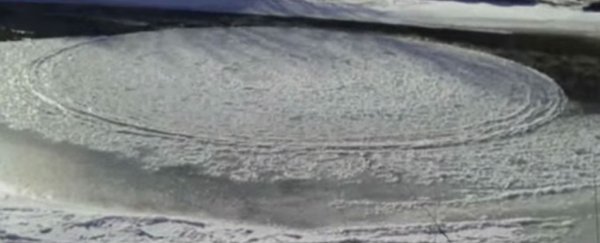New physics doesn't always come from the recesses of space or the bowels of the Large Hadron Collider. Sometimes, you just need some cameras, a nickel bead, a magnet, and Petri dish popsicles.
Every once in a while, someone notices a big disc of ice eerily spinning in a river. These discs can be anywhere from 1 to 200 metres across, and almost everything about them has mystified physicists and environmental scientists for over a century. While it's thought that this rare natural phenomenon is likely was caused by cold, dense air coming in contact with an eddy in a river, no one's been able to definitively explain why these giant discs continue to rotate as they melt. Until now.
The most common explanation for the spinning ice discs says that as the discs float along in a river, they're spun around by eddies - little spinning currents that form when water flows over rocks or into an enclosed space. And while this is this is probably part of what's happening, it can't be the whole story.
If eddies were the only culprit, small discs would spin faster than big discs, and this isn't at all what people see: discs across that huge range of sizes rotate at pretty much the same rate. Even worse for the prevailing wisdom, you'd expect that discs in still water, where there aren't any eddies, wouldn't start spinning, but they do.
A team led by Stéphane Dorbolo from the University of Liége in Belgium tested this by carefully putting homemade ice discs - formed by freezing water in a Petri dish that had a little nickel ball at the centre - in a tank of still water with a magnet held above it. Nickel is just magnetic enough that the ball wanted to stay right under the magnet, meaning that the discs could spin but they couldn't move around on the surface.
Then, the researchers recorded what the discs did as they melted. Despite not being able to move around, the discs still rotated.
That raised the question of how these discs could be rotating if they're not being swept by any eddies in the water. Luckily, in an experiment without the nickel ball keeping the discs in place, the team found a clue: the discs spun faster in warmer water.
When they decided to track what the water itself was doing when the discs were held still, they found something interesting: right below the centre, water was flowing down after it melted off of the disc instead of hanging around and flowing away gradually.
Now, water is a little weird in the molecular kingdom. Most substances get denser as they get colder, which makes their solid form denser than their liquid form. Solid metal, for instance, sinks in liquid metal. Water follows this trend to a point, but then the density goes back down just before freezing. This is why ice floats; water is at its densest a couple degrees above its freezing point.
So when water melted off of the discs, it was denser than anything around it, and it fell straight down. The higher the temperature of the surrounding water, the bigger the density difference, and the faster the melting water would sink.
But water can't really go straight down. If there's any sideways movement at all, the water will start spinning as it sinks, just like it spins as it goes down a drain or in your toilet.
And sure enough, this is exactly what the researchers saw: the water underneath the ice discs was spinning as it went down, and this spinning was pulling the discs around. So these ice discs are spinning because they're melting, and that melting water spins as it sinks below the discs.
You'll sometimes hear physicists say that the era of learning something from a tabletop experiment is dead. Well, this team of physicists just learned something fascinating by holding popsicles in place with a magnet and watching what happened.
The new study has been published in Physical Review E.
